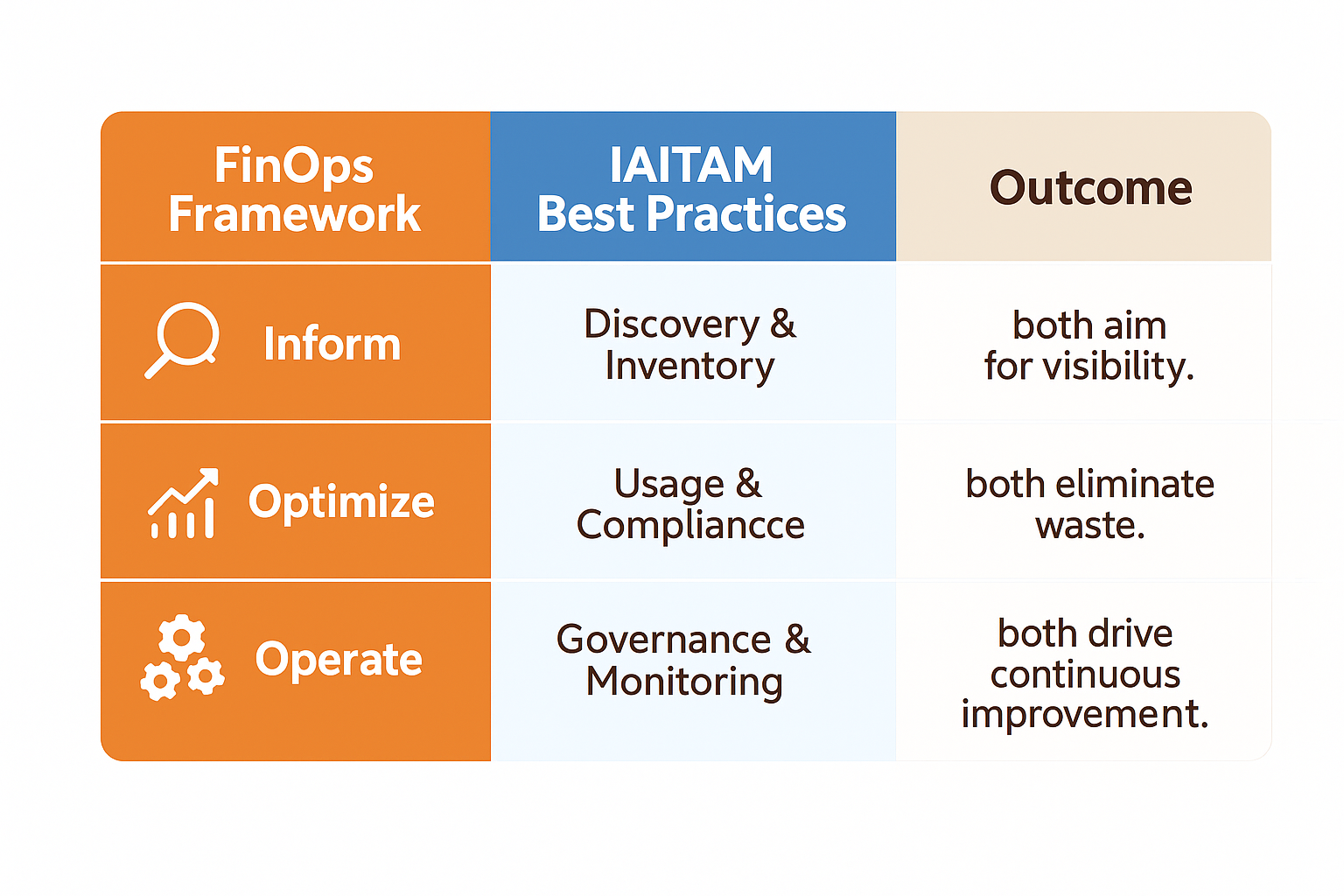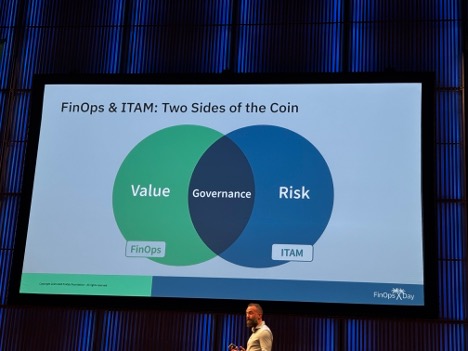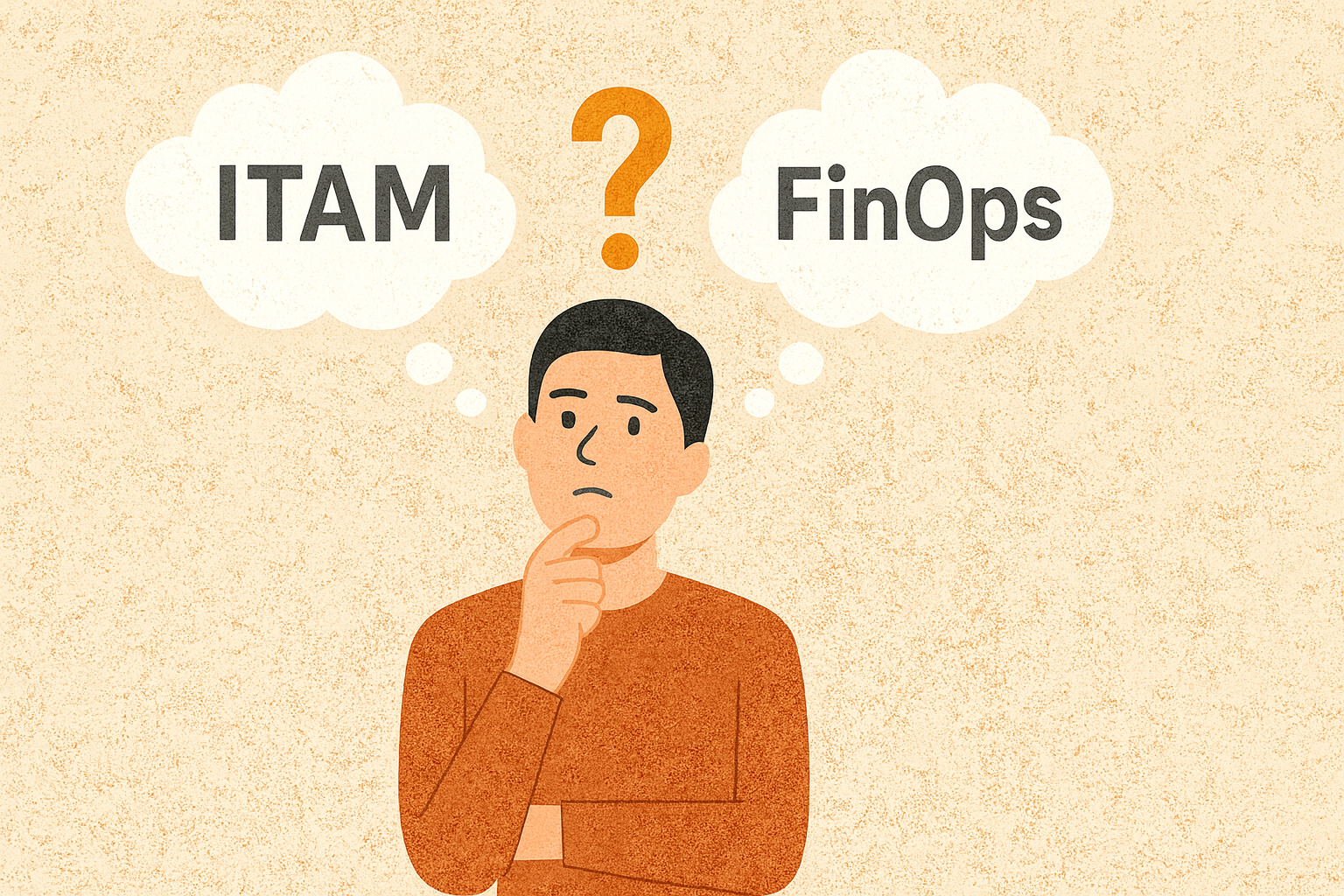After spending more than a decade in On-premises infrastructure and IT Asset Management (ITAM) and transitioning into the world of FinOps for almost 2 years, I’ve had the unique experience of living on both sides of the fence. Having to manage risk and compliance for on-premises assets and knowing the challenges of chasing value optimization in the cloud.
Attending FinOps X Amsterdam was such an eye-opener. I saw ITAM and FinOps professionals sharing the same space for the first time, yet it was clear there is still a gap in understanding the two worlds especially during one of the Chalk Talk Sessions about Building an ITAM/FinOps business case. It became clear that we don’t always see each other’s strengths and sometimes even see overlap as competition. But in reality, there is a huge opportunity for collaboration.
What is ITAM and FinOps all about? Let’s talk origin.
Let’s recap what FinOps and ITAM are about and how their histories shape the way they approach technology challenges:
FinOps grew up in the cloud, but the framework has since evolved. The FinOps Foundation recently updated its definition: instead of focusing only on cloud, it now addresses all technology spend. The mission remains the same: maximizing the business value of technology investments. Its framework is structured into three iterative phases:
- Inform (visibility and allocation),
- Optimize (Rates & Usage),
- Operate (continuous improvement and usage).
ITAM, meanwhile, has a longer history. It was born in the datacenter and has matured into a discipline that covers the entire lifecycle of technology assets. ITAM can be divided into 2 core disciplines:
- SAM (Software Asset Management): managing entitlements, usage, and compliance for software. Either on-premises, SaaS, or running in the cloud.
- HAM (Hardware Asset Management): tracking the lifecycle of physical devices and infrastructure, from procurement to retirement, increasingly important as hybrid models blend on-prem and cloud.
Over the years, both SAM and HAM have evolved into the cloud era. SAM now covers SaaS governance and bring-your-own-license (BYOL) in IaaS/PaaS environments, while HAM supports hybrid infrastructure management, where hardware and cloud services are tightly linked.
But here’s the key: even though both disciplines have expanded, their core skillsets remain rooted in their origins. FinOps is strongest in public cloud spending and optimization, while ITAM is strongest in on-premises lifecycle and licensing.
That’s why they need to make use of each other. For example, when creating a deployment plan:
- ITAM is best placed to calculate the cost, risk, and lifecycle implications of on-prem investments.
- FinOps is best suited to forecast, allocate, and optimize spend in the cloud. Together, they give organizations a complete picture on both sides of the hybrid world.
What About Blind Spots? Let’s Talk Challenges.
So now you know what ITAM and FinOps are, and what their origins, strengths, and objectives look like. But what about the areas where they struggle? Every discipline has blind spots and because of their different starting points, ITAM and FinOps face unique challenges in seeing into each other’s domains.

The challenge is clear:
- FinOps often lacks deep visibility into fixed, contract-heavy on-premises and license costs.
- ITAM often lacks granular insight into dynamic, usage-based cloud spend. Neither can cover the whole spectrum alone and that’s why collaboration is essential.
Showback and Chargeback: A Tale of Two Approaches
One of the defining capabilities of FinOps is showback and chargeback making technology costs transparent and allocating them back to the business units that generate them.
In the cloud world, the concept is simple. Every resource has usage data, billing is granular, and costs can be mapped down to the team, project, or even the individual workload.
This makes it possible for FinOps teams to deliver real-time dashboards, cost-per-transaction metrics, and accurate chargeback models. Showback in FinOps isn’t just about reporting it actively changes behavior, because engineering and product teams see the financial impact of their choices almost immediately.
For ITAM, the principle has always existed, but the practice is far more complex. Allocating the cost of software licenses, SaaS subscriptions, or hardware devices back to business units often relies on procurement data, HR allocations, or static entitlement records. Unlike the cloud, where usage is elastic and visible, traditional IT assets are:
- Harder to meter: licenses don’t always provide real-time consumption data.
- Shared across units: infrastructure or enterprise licenses often cover the entire organization, making attribution messy.
- Bound by contracts: costs are often fixed, regardless of usage.
- As a result, ITAM-driven showback and chargeback tend to be periodic and less dynamic than FinOps.
This shows why the two need each other: FinOps thrives in consumption-based, elastic environments, while ITAM brings structure to the contract-heavy world of licenses and hardware. Together, they provide accountability across the full technology landscape.
How Has ITAM Evolved? Let’s Talk Cloud.
We’ve covered the origins, strengths, objectives, and the blind spots that come from those different starting points. One nuance matters: ITAM has always been a lifecycle-first discipline across hardware and software not a narrow “on-prem license” function. What’s changed is the environment and the metrics: more SaaS, more IaaS/PaaS entitlements, and richer data to govern them. Today’s ITAM practice spans hybrid and cloud just as naturally as the datacenter:
- SaaS portfolio governance: entitlement hygiene, seat reclamation, tier right-sizing, SSO alignment to business roles, and renewal planning based on real usage.
- Cloud entitlements & BYOL: mapping license rights to workloads in IaaS/PaaS, validating portability rules, and preventing double-spend between on-prem and cloud deployments.
- Hybrid inventory & discovery: mapping tags/labels, CMDB, and asset repositories across VMs, containers, marketplace SKUs, and physical devices.
- Contract & commitment management: aligning enterprise agreements and cloud commitments with actual demand, and sequencing exits from legacy terms.
- Risk & compliance in the cloud era: audit readiness now includes SaaS and cloud services, not just installed software.
- Financial integration: allocating fixed obligations and renewal costs to business units, and feeding that into showback/chargeback models. In parallel, FinOps has evolved too from cloud-only financial management to a broader focus on technology spend overall, while keeping its value lens: visibility, unit economics, optimization, and governance (including showback/chargeback).
ITAM has broadened its governance footprint across SaaS and cloud; FinOps has broadened its value lens across all technology. That’s exactly where they meet and why using each other’s strengths is essential in a hybrid world.
How Do the Frameworks Compare?
The FinOps Foundation framework is deliberately structured around three phases: Inform, Optimize, and Operate to guide organizations on their cloud cost journey. By contrast, the IAITAM Best Practices do not use this same three-phase model. Instead, IAITAM is built as a process-oriented framework with twelve Key Process Areas that cover the full lifecycle of IT assets. Still, when you look closer, there are natural parallels. Discovery & Inventory, Usage & Compliance, and Governance & Monitoring within IAITAM resemble the Inform, Optimize, and Operate phases of FinOps more than any other grouping. They don’t map one to one, but they echo the same rhythm: first gain visibility, then control usage, and finally drive governance and continuous improvement. The table below shows how these two perspectives align.

Where ITAM stretches further is in procurement and retirement, while FinOps shines in continuous iteration and technology economics. Together, they cover the full lifecycle of technology value management.
Why Collaboration Matters
So, what happens when these two disciplines come together? We stop worrying about ownership and start asking: how do we make each other stronger?
- Deployment planning: ITAM calculates on-prem lifecycle cost, FinOps forecasts and optimizes cloud spend.
- Hybrid cost management: FinOps handles forecasting and unit economics, ITAM handles contract and lifecycle optimization.
- Governance: ITAM mitigates risk, FinOps ties spend to business value.
- Reporting: Both have dashboards but when cost, value, and risk are combined, leadership gets a complete story.
- Negotiations: FinOps brings usage data, ITAM brings contractual leverage. Together, they’re much stronger at the vendor table.
And this isn’t just theory. The ITAM Forum has published a great piece outlining six collaborative use cases for ITAM and FinOps teams working together. A few highlights:
- Cloud cost optimization during renewals: ITAM and FinOps share data to influence vendor negotiations.
- License compliance in cloud environments: ITAM ensures BYOL and SaaS entitlements are honored while FinOps tracks real usage.
- Showback/chargeback alignment: FinOps provides granular cloud allocation, ITAM extends the model to fixed contracts and lifecycle costs.
You can read the full set of use cases here: 6 Collaborative Use Cases for FinOps and ITAM Teams (ITAM Forum)
Want to Go Deeper?
If you’d like to explore how both the FinOps and ITAM Forum communities frame these overlaps, here are two great resources I recommend:
How ITAM Intersects with FinOps Capabilities (FinOps Foundation) This article breaks down the overlaps across the different FinOps Capabilities in regard to ITAM
The What and Why of FinOps (ITAM Forum) This piece explains how FinOps emerged as a cultural practice and why it’s so critical in tying cloud spend directly to business outcomes.
My article shares a practitioner’s perspective having worked in both ITAM and FinOps but these guides give you the official view from both communities. Together, they provide a more complete picture.
Final Thought
Two years ago, at a SAM event, I heard the following quote from Gartner:
By 2025, 50% of organizations will unify SAM and FinOps into a consolidated discipline for portfolio cost management and governance.
That perfectly represents our current trajectory. At their core, FinOps ensures technology spend drives value, while ITAM ensures technology spend doesn’t expose us to risk. In today’s world, neither discipline can succeed alone and Gartner’s prediction highlights just how urgent that convergence has become.
It’s why I’m especially enthusiastic about the partnership between the FinOps Foundation and the ITAM Forum. This alignment isn’t symbolic it’s foundational. It opens doors for the two communities to learn from each other, strengthen each other’s capabilities, and build a shared language for technology spend and risk management.
Let’s keep the conversation going. There’s a lot we can pick up from each other if we’re willing to share openly and lean on each other’s strengths. The frameworks may have evolved, but the foundations hasen’t changed
FinOps still excels in cloud economics, and ITAM still leads in lifecycle governance. Put those together, and it’s not just overlap it’s an opportunity to make both disciplines stronger.
Let us know what you think about the blindspots and how the Frameworks should evolve.



